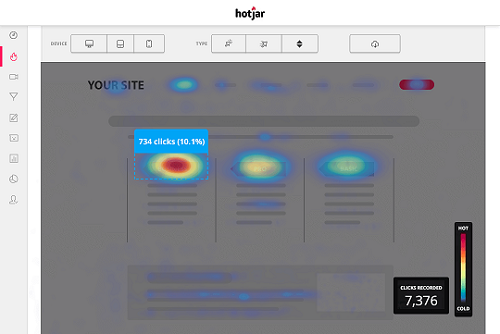Analytics – What They Are and How to Use Them
 |
| firstsitesolutions.com |
Now a wide range of analytics tools are available for
everyday use, some of them just track page stats whilst others are geared more
towards social media. Even with that taken into account, making that initial
commitment to learning about analytics and using them can be more than a little
bit unnerving, which is where we come in. In this post I will outline some basic
information about how to use analytics to improve your site’s viewership, which
tools are best and the relationship between analytics and social media.
Firstly then, what exactly are web analytics? Simply put,
they are the viewer statistics for specific sites. Total site views, page
views, shares and how all these spread chronologically and geographically all
fall under this umbrella. By looking at your web analytics, you can discern
when your views have peaked or troughed, which posts have been more popular,
which countries view your site more frequently and plenty more besides. There’s
a wealth of information to be gleaned, but how do you take that information and
turn it into something productive, something strategic?
At the most basic level, it’s a case of identifying focal
points and exploiting them. Say you notice that your page views spike on
Tuesday afternoons, post more during that time. Say you notice that posts you’ve
shared on Pinterest are getting more activity than all the others, implement Pinterest
more. A lot of views coming in from Australia? Put up some Australia related
content, if you can make it relevant to your site’s purpose. If a particular page
on your site is distinctly popular, get more links on there, turn your site
into a better closed circuit, redirecting views between different pages as much
as humanly possible.
As well as where your viewers are going, you can also get an
idea of where they came from. Analytics tools will show you who found your site
via an organic search, actually putting your address in the URL bar or from
clicking a link. Better tools will even tell you which site that link came
from. This has the added benefit of telling you if anyone is sharing your
content, that way you can find out who they are and send them a cake or
something as a thank you (or just encourage them to keep sharing your stuff).
So which tools are best? There are so many readily available
that there’s no one ‘best’ tool for everyone, or even one that covers all the
bases, often it’s better to use a combination of different ones. Here’s a
rundown of some of the better options.
Google Analytics
This is by far the most popular tool available. It’s free,
which is a nice jumping off point and it’s directly linked to the most
powerful, popular search engine on the planet, also a plus. It’s brilliantly
easy to understand and comes jam-packed with features and tools which enable
you to tailor it to your specific needs.
Kissmetrics
Perhaps the most popular professional platform, it’s not
cheap, running from $149 a month and upwards, but the information you get back
is richly detailed. You get a lot more information about keyword performance,
email performance and you can track a visitor’s exact path through your site,
like some kind of web detective. Visually it’s really straightforward and
eye-catching, definitely one to consider if you’re willing to put the cash
down.
Mouseflow
The slick, trendy option, Mouseflow will only run you $13 a
month at base level, but for that you get an interactive video feed of viewer
activity, visually represent every click, keystroke and scroll. Creepy? Kind
of. Useful? Very. You also get a kind of ‘heat map’ of overall activity, it’s
the same information you get with other tools, but displayed in a much slicker
way.
Sprout Social
As much a social media management tool as an analytics one,
Sprout Social starts at $59 a month, but also offers a 30 day free trial. You
can schedule posts across multiple platforms and accounts just like with any
other management tool but it also gives you detailed stats on views and
engagements. Competitive insight is a particularly useful feature, it shows you
who you’re up against and how to keep up or even get ahead.
SocialRank
Originally optimised specifically for Twitter, SocialRank
has now made the expansion over to Instagram as well. This one is best used in
tandem with one or more the above, since it’s so social media specific. It
takes all your followers and shows you which followers engage with your
material the most, which ones are more likely to favourite, which ones have
tagged you and much more besides. Currently it’s totally free, but a premium,
subscription based iteration is in the works.
Sysomos
By far and away the most comprehensive social media
analytics tool on the market. It takes data from just about every platform you
care to name as well as forums, news pages, wiki pages and more. It provides more
demographical information than just about any other tool, allowing you to
pinpoint your target audience with laser focus. If you run a blog or a media
site, this is an invaluable resource. To sweeten the deal it also comes
outfitted with an arsenal of other, antecedent tools like SysmosMAP, a
pheominally detailed keyword data analyst that literally searches all of
history. No set pricing for this one, but you can request a demo here.
That’s just a small snapshot of the wealth of different tools
out there at your disposal. Once you’ve pinned down the best option for you
personally, it’s a case of figuring out exactly how to use the wealth of
information at your disposal to build your audience. The key is to document
everything, every spike, every slump, every anomaly so that you can build a
strategy for getting your site as noticed as possible. Knowing which social
media platforms fit your site best is vital and once you’ve figured that out,
make sure you’re using the best wrench for that particular bolt. It might seem
daunting, but once you actually start, it will immediately start getting
easier. Treat it like a game, but play to win.
Callum Davies
Callum Davies
Callum is a film school graduate who is now making a name for himself as a journalist and content writer. His vices include flat whites and 90s hip-hop. Follow him @CallumAtSMF
Contact us on Twitter, on Facebook, or leave your comments below. To find out about social media training or management why not take a look at our website for more info http://socialmediacambridge.co.uk/.
Analytics – What They Are and How to Use Them
 Reviewed by Unknown
on
Wednesday, April 29, 2015
Rating:
Reviewed by Unknown
on
Wednesday, April 29, 2015
Rating:
 Reviewed by Unknown
on
Wednesday, April 29, 2015
Rating:
Reviewed by Unknown
on
Wednesday, April 29, 2015
Rating:















 Entrepreneur, international speaker on Social Media Marketing. First one in the UK to write and speak in conferences about Twitter as a marketing tool. Consultant to Corporate Companies, Government Organizations, Marketing Managers and Business Owners.
Entrepreneur, international speaker on Social Media Marketing. First one in the UK to write and speak in conferences about Twitter as a marketing tool. Consultant to Corporate Companies, Government Organizations, Marketing Managers and Business Owners. Aspiring novelist with a passion for fantasy and crime thrillers. He hopes to one day drop that 'aspiring' prefix. He started as a writer and soon after he was made Executive Editor and Manager of the team at Social Songbird. A position he held for 5 years.
Aspiring novelist with a passion for fantasy and crime thrillers. He hopes to one day drop that 'aspiring' prefix. He started as a writer and soon after he was made Executive Editor and Manager of the team at Social Songbird. A position he held for 5 years. Musician, audio technician, professional tutor and a Cambridge university English student. Interested in writing, politics and obsessed with reading.
Musician, audio technician, professional tutor and a Cambridge university English student. Interested in writing, politics and obsessed with reading. Recently graduated with a BA in English Literature from the University of Exeter, and he is about to study an MA in Journalism at the University of Sheffield. He is an aspiring journalist and novelist; in his free time he enjoys playing chess, listening to music and taking long walks through nature.
Recently graduated with a BA in English Literature from the University of Exeter, and he is about to study an MA in Journalism at the University of Sheffield. He is an aspiring journalist and novelist; in his free time he enjoys playing chess, listening to music and taking long walks through nature. Lucy is an undergraduate BSc Politics and International Relations student at the London School of Economics and Political Science.
Lucy is an undergraduate BSc Politics and International Relations student at the London School of Economics and Political Science. Anna Coopey is a 4th year UG student in Classics at the University of St Andrews in Scotland. She is a keen writer and researcher on a number of topics, varying from Modern Greek literature to revolutionary theory.
Anna Coopey is a 4th year UG student in Classics at the University of St Andrews in Scotland. She is a keen writer and researcher on a number of topics, varying from Modern Greek literature to revolutionary theory.
